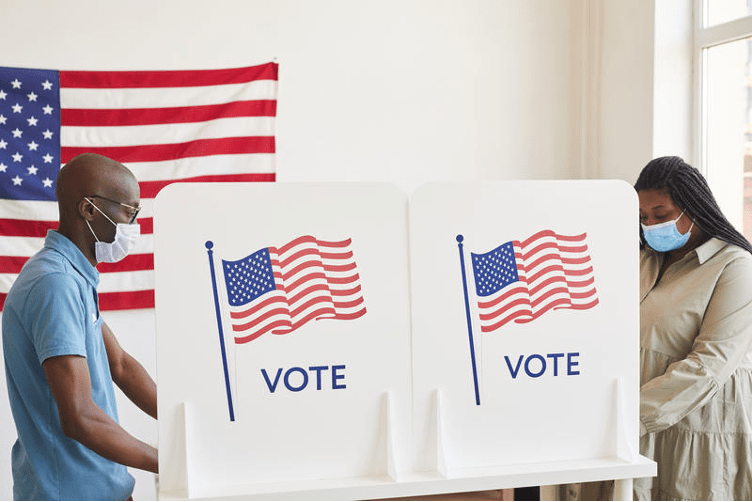By Kési Felton, Contributing Reporter

The 2018 midterms saw the highest voter turnout rates in a century, especially among youth voters and voters of color. However, this year’s coronavirus pandemic has left many — from political campaigns to pundits to voters themselves — worried about how turnout rates will be affected in the 2020 presidential election, despite a surge in voting by mail as many Americans exercise caution and comply with shelter-in-place orders.
The current administration’s pandemic response, coupled with social unrest and an economic downturn, has given Americans myriad reasons to make their voices heard at the ballot box. Nevertheless, many voters are trepidatious about the health consequences of voting in the middle of a pandemic. They are also very clear about the political consequences that seem inevitable if they don’t.
Turnout in recent presidential elections has averaged about 60% of those eligible to vote, which is lower than in many other developed countries. This year may be different. Georgia saw an unprecedented 128,000 voters at the polls on the first day of early voting on October 12, according to the Atlanta Journal Constitution. Several other states, including Texas and North Carolina, have also seen record-setting numbers of early votes with several days to go. This has given some hope that these high turnout numbers will persist through Election Day.
“In this upcoming 2020 election, COVID-19 will certainly affect the turnout,” said Jeff Totty, voter file administrator and grassroots director for the Democratic Party of Georgia. “Voters will have to ask themselves if they want to take a chance of becoming infected and vote in person. If they think it’s too risky for them, their only other option is to vote by mail.
“This has led to what’s being called the Blue Shift…[which] predicts that Republican voters are much more likely to vote in person on Election Day because Donald Trump has been saying over and over again that COVID- 19 is no big deal. Democratic voters will be much more likely to vote by mail because they’ve been focused on the real health effects of COVID-19,” Totty said.
These circumstances compound the usual factors that influence registered voter turnout. So what are the factors that get people to actually vote?
Statistics show that newly registered voters are the lowest group of voters to actually turn out.Jeff Totty, Democratic Party of Georgia
They include electoral competitiveness, election type (primary/general, presidential/midterm, or local/federal), electorate demographics and voting laws, according to the election reform advocacy group Fair Vote. Primaries, midterms and local races generally attract fewer voters. In terms of demographics, those who turn out tend to be older, wealthier, more educated and whiter, Fair Vote reports.
In addition, “when people aren’t invested in the outcome of an election or when the candidates are both largely unpopular, turnout will drop,” Totty said.
Totty also cited voter suppression tactics as an influence on turnout rates. Examples of those tactics include the removal of voting machines and confusing ballot questions. This can result in long lines that many working Americans aren’t willing or financially able to endure.
With so many factors influencing turnout, it’s clear that getting people registered is important, but just the first step.
“People will often ask why campaigns don’t do more voter registration and the reason is this: running an effective program to register voters is extremely expensive. You’ll need to hire a team of canvassers and send them to an area that has lots of unregistered voters. Then they’ll need to find those folks and get them to register,” Totty said. “Then you need to get those folks to actually cast a vote for that campaign, when the statistics show that newly registered voters are the lowest group of voters to actually turn out,” he said.
Referencing statistics from Georgia’s June 9 primary, Totty noted that “people that registered to vote from January 2020 to May 2020 had a brutal 16 percent turnout in the June primary.”
Nevertheless, there have been unprecedented efforts to mobilize people to register to vote this year. People are able to register online in minutes — which is especially convenient for quarantined Americans. The results, however, do not reflect these efforts.
The Brennan Center for Justice noted in a study released ahead of National Voter Registration Day in September that voter registration growth rates in 2020 were an average of 38 percent lower in 17 states compared with 2016.
“Only about 64% of the U.S. voting-age population (and 70% of voting-age citizens) was registered in 2016, according to [a] Census Bureau report, compared with 91% in Canada (2015) and the UK (2017), 96% in Sweden (2014), and 99% in Slovakia (2016),” the Pew Research Center reported.
Two factors that separate the U.S. from places like Canada and Europe are that voter registration here is an obligation of the individual as opposed to the government and other countries have the capacity for data-sharing between government agencies, allowing for automatic registration and updates, for example, to one’s address.
The pandemic has created more interest in the idea of online elections, which has long been a rallying point for disabled Americans trying to exercise their right to vote. Few states currently offer online or mobile voting options and then only for special circumstances. And given the ongoing threat of another instance of election interference, widespread support for online voting is unlikely.
Ultimately, many factors influence people to not only register to vote but to also turn out at the polls. While the motivating factors that get them there are subjective, voter turnout rates are a function of the broader political culture.
If the goal is to increase average turnout over a sustained period of time and not just sporadically in individual election cycles, communities could start with promoting civic education in schools and neighborhoods, passing laws that make it easier for people to get registered and vote and stamping out efforts to suppress and disenfranchise voters, a Brookings Institution policy paper found.
This article is courtesy of TruthBeTold.news.









